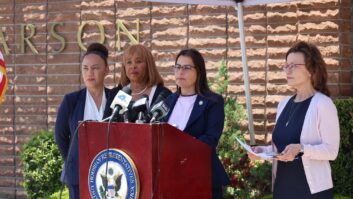Deborah D. McAdams reports on a recent EAS presentation and discussion in Los Angeles; the story originally appeared in RW sister publication Television Broadcast.
BURBANK, CALIF.: Broadcasters have 106 days to retrofit their emergency alert operations to process a new open-standard, XML-based messaging format known as “Common Alerting Protocol.” Don’t count on another extension of the compliance deadline, Bruce Robertson of Digital Alert Systems told a group of broadcast engineers this week.

“There’s still a lot in my estimation that needs to be defined,” he said, though enough information is in place to go forward. “One six-month extension has already been granted. It may be advisable, but at this particular point, I don’t believe there’s going to be any extension of that September 30 deadline.”
The CAP standard was approved last fall by the Federal Emergency Management Agency to amalgamate the alerting process for the various agencies that issue warnings. Using CAP, local, state and federal officials will, in theory, be able to send a single warning that can be picked up by TVs, radios, cellphones, computers and other communications platforms such as digital signage.
Multiple emergency management agencies must be contacted to distribute a national alert with the current system. It’s main distribution platform is the Emergency Alert System comprising TV and radio, and consists mainly of the familiar break-in tone followed by an audio warning and text. CAP also enables the use of files, images, video and hyperlinks, Robertson told members of the Los Angeles chapter of the Society of Broadcast Engineers on Tuesday.
NETWORK vs. DAISY CHAIN
CAP is part of a larger federal effort to update the nation’s emergency alert capability, known as the Integrated Alert Public Warning System, or IPAWS. Where the old EAS structure was a daisy chain of sorts–where designated radio stations in each market received the original alert and sent it to a list of TV and radio stations, which in turn sent it to other radio and TV operations, including cable and satellite. The new structure is a data network system whereby an alert is sent to an Emergency Operations Center, which files the message and forwards it to a server.
“Getting it out from the file server is still being worked on,” Robertson said. “It’s defined as an initial push, and then a pull to load it.”
An engineer at the SBE meeting responded that RSS feeds could be employed, and that the new CAP converter boxes would do the pulling by pinging the EOC server at defined intervals.
CAP CONVERTERS
CAP converters are supposed to be Part 11 specified, to insure every certified product, independent of the vendor, can communicate with other productions with that spec. Robertson noted that few vendors offer CAP converter boxes with conformity certification. (A search of FEMA’s Responder Knowledge Base product page shows three.) He reminded the group that converters would not install inline with old EAS equipment, but required additional audio inputs.
Robertson said that, unlike the current EAS system, CAP allows frequent updates.
“If you issued a storm warning for an hour, you couldn’t go back and retract it. You’d have to issue another storm warning for a shorter period of time. CAP will be a digital database that allows frequent updates available via the EOC servers,” he said.
However, he said. each new update generates a new EAS activation, with more interrupts. It is also still uncertain if the devices can support “governors must-carry” messages.
The gear itself is not expense, Robertson said. The cost “per stream” can be less than $1,000 in some cases, but he said to plan for long-term consequences. Gear must be flexible enough to accommodate change, and be two-way software driven to enable upgrades. He also said that while one TCP/IP port is sufficient now, more would provide for “segmentation.”
There’s also the issue of being able to accommodate TCP/IP. “There are still stations out there on mountains without Internet connections.” Robertson noted. He recommended that stations “consider installation of a dedicated Internet connection for CAP equipment.” He said he didn’t know of any current products available to enable legacy EAS equipment to handle CAP.
ELECTRONIC LOGGING
One new key element of CAP for broadcasters is that it streamlines the logging process. Broadcasters are required to keep a log of all EAS tests. CAP enables electronic logging, which the FCC has OK’d as long as a record can be printed out upon request. Robertson stressed the importance of keeping accurate logs.
“The FCC Enforcement Bureau has leveled several EAS fines lately,” he said. One recent example is a Comcast system in Florence, Ala., that was fined $16,000 for not retransmitting EAS messages to “certain customers,” according to the FCC notice. Last fall, a Kansas broadcaster incurred $11,000 in fines for not having EAS equipment plugged in, and thus failing to conduct the required tests.
THIS IS ONLY A TEST
While broadcasters conduct weekly and monthly tests within their designated market areas, no national test has ever been conducted–intentionally. Robertson said the Emergency Activation Notification was twice activated accidentally. Two limited-area tests were conducted in Alaska in the last year-and-a-half that left “a lot of things to be desired,” Robertson said. Glitches included dead air, improperly installed or nonfunctional decoders, and bad audio.
Audio remains a concern for broadcasters, now facing a nationwide test scheduled for Nov. 9, 2011 at 2 p.m. EDT.
“I know this is a big issue, from engineers to program directors to general managers,” said Adrienne Abbott, chair of the Nevada SECC and a founding member of the Broadcast Warning Working Group. Abbott attended a FEMA/EAS virtual roundtable June 9 and posted her observations. “Everyone has a concern or complaint about audio quality issues. . . We have all tried to work with our state and local emergency managers and the National Weather Service on improving the audio quality.”
The audio issue was clear on the morning of Feb. 28 in Los Angeles when KCRW-FM passed through an AMBER Alert from the L.A. County Sheriff’s department. The message was garbled and nearly indecipherable. (See “Amber Alert Radio Transmission is Barely Audible.”)
TO COME
Robertson reminded broadcasters that comments are due June 28 on the Federal Communications Commission’s CAP-compliance proposed rulemaking. It seeks feedback on the use of RSS feeds; a possible extension for stations without Internet connectivity; and FCC compliance testing of equipment, among other items. The docket is No. 04-296.
Robertson said to expect other considerations not yet mentioned in the docket. He said two committees were involved in work on closed-captioned emergency messaging on the Internet and video description emergency messaging on TV over IP.
“One of the sad things about these committees is that television stations were not heavily represented in these areas,” he said.
~ Deborah D. McAdams, Television Broadcast
See . . .
June 15, 2011: “Alabama Has ‘First Statewide CAP-Compliant Rollout”
Global Security Systems said its GSS Alert Studio has been designated the official origination and retrieval tool for Alabama’s Emergency Alert System.
June 10, 2011: “EAS National Test Date Raises More Questions”
Questions from broadcasters and others on the SBE EAS listserv today include how often a national EAS test might be conducted after the initial test and exactly what it may entail.
June 9, 2011:“First National EAS Test Scheduled for November”
The Federal Emergency Management Agency and the Federal Communications Commission will conduct the test Wednesday, Nov. 9 at 2 p.m. EST. The duration may last up to three-and-a-half minutes.
May 9, 2011: “EAS Gear Receives FEMA’s OK”
The Monroe Electronics Digital Alert Systems division today said its digital emergency alert platforms have been certified compliant for the new Integrated Public Alert and Warning System.
February 8, 2011: “FEMA: List of CAP-Compliant Gear Expected in March”
Several experts say broadcasters will continue to be the backbone in a new Emergency Alert System. That’s one bit of news out of a recent webinar on broadcasting’s transition to the Common Alerting Protocol for next-generation EAS, which will encompass wireless and broadband platforms.
September 30, 2010: “FEMA Adopts Standard for Emergency Alerts”
“People get their news and information from a wider variety of sources today than ever before, and it’s important that emergency management officials are able to reach members of the public no matter what medium they may be using. The Common Alerting Protocol gives us the opportunity to send one message over all IPAWS alert systems at the same time.”






